A Comprehensive Report on Safe Design and Execution of Demolition
VerifiedAdded on 2020/04/15
|13
|2627
|216
Report
AI Summary
This research paper, focusing on the safe design and execution of demolition, delves into the critical aspects of demolition work within the framework of work health and safety regulations. It emphasizes the importance of a systematic risk management process, including hazard identification, risk assessment, and the implementation of control measures. The paper explores various demolition methods such as manual, mechanical, induced collapse, and the use of explosives, highlighting the associated safety considerations for each. It also addresses the importance of demolition planning, including the identification of hazards, assessment, and control measures. The paper emphasizes the need for considering the structure's integrity, potential hazards like asbestos and hazardous materials, and the selection of appropriate demolition methods. It covers the roles of designers, the need for demolition licensing, and the importance of reviewing control measures to ensure continued safety. Overall, the report provides a comprehensive overview of safe demolition practices, aiming to minimize risks and ensure the health and safety of workers and the public.
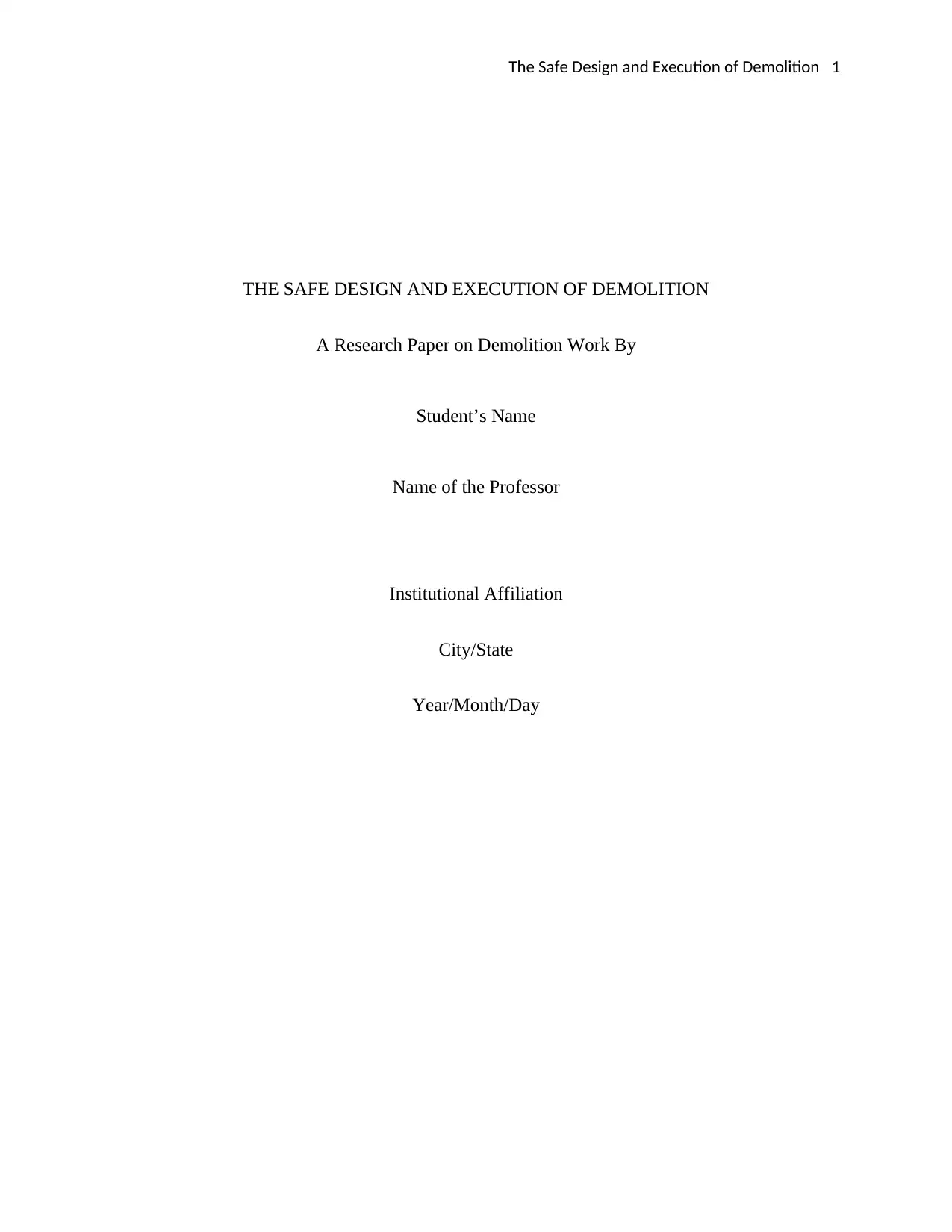
The Safe Design and Execution of Demolition 1
THE SAFE DESIGN AND EXECUTION OF DEMOLITION
A Research Paper on Demolition Work By
Student’s Name
Name of the Professor
Institutional Affiliation
City/State
Year/Month/Day
THE SAFE DESIGN AND EXECUTION OF DEMOLITION
A Research Paper on Demolition Work By
Student’s Name
Name of the Professor
Institutional Affiliation
City/State
Year/Month/Day
Paraphrase This Document
Need a fresh take? Get an instant paraphrase of this document with our AI Paraphraser
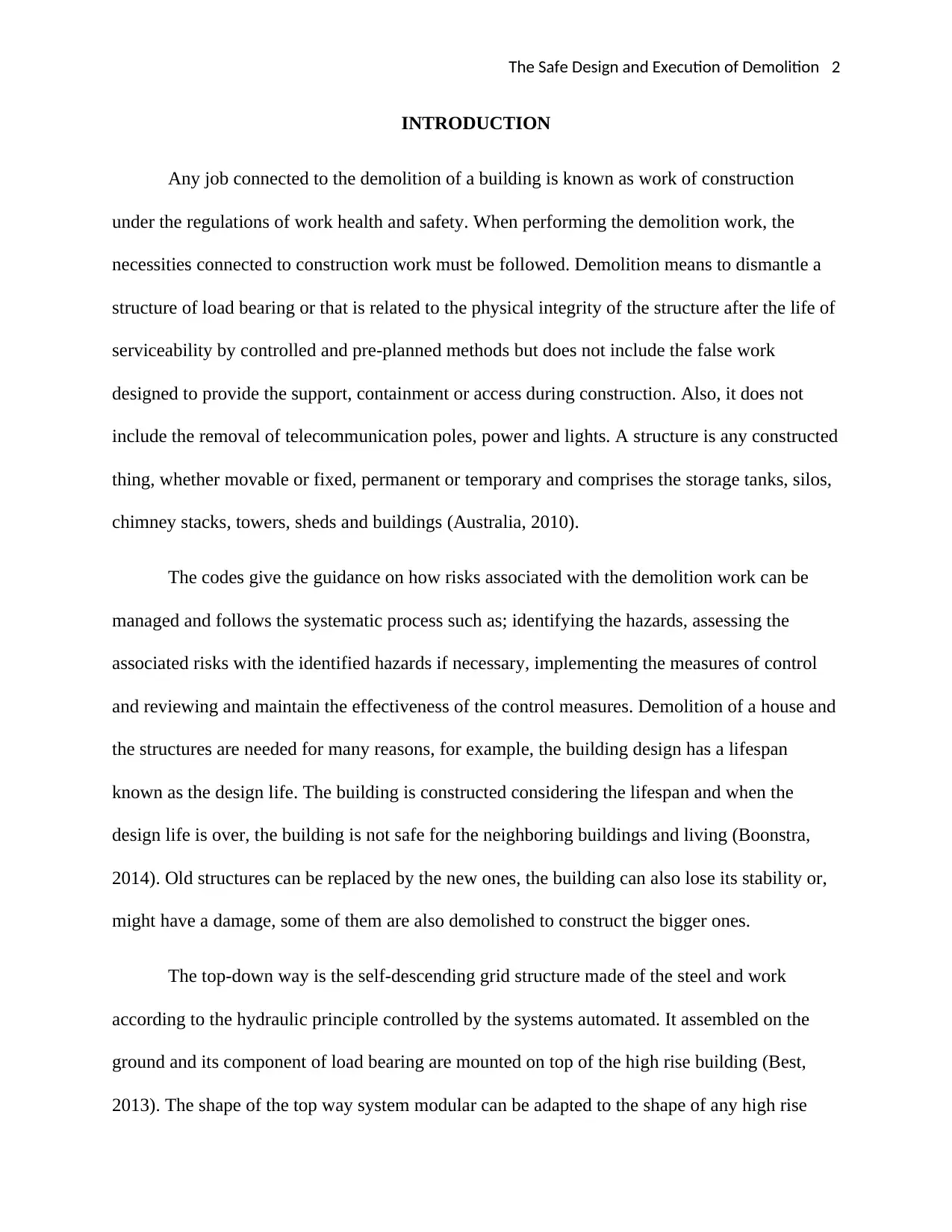
The Safe Design and Execution of Demolition 2
INTRODUCTION
Any job connected to the demolition of a building is known as work of construction
under the regulations of work health and safety. When performing the demolition work, the
necessities connected to construction work must be followed. Demolition means to dismantle a
structure of load bearing or that is related to the physical integrity of the structure after the life of
serviceability by controlled and pre-planned methods but does not include the false work
designed to provide the support, containment or access during construction. Also, it does not
include the removal of telecommunication poles, power and lights. A structure is any constructed
thing, whether movable or fixed, permanent or temporary and comprises the storage tanks, silos,
chimney stacks, towers, sheds and buildings (Australia, 2010).
The codes give the guidance on how risks associated with the demolition work can be
managed and follows the systematic process such as; identifying the hazards, assessing the
associated risks with the identified hazards if necessary, implementing the measures of control
and reviewing and maintain the effectiveness of the control measures. Demolition of a house and
the structures are needed for many reasons, for example, the building design has a lifespan
known as the design life. The building is constructed considering the lifespan and when the
design life is over, the building is not safe for the neighboring buildings and living (Boonstra,
2014). Old structures can be replaced by the new ones, the building can also lose its stability or,
might have a damage, some of them are also demolished to construct the bigger ones.
The top-down way is the self-descending grid structure made of the steel and work
according to the hydraulic principle controlled by the systems automated. It assembled on the
ground and its component of load bearing are mounted on top of the high rise building (Best,
2013). The shape of the top way system modular can be adapted to the shape of any high rise
INTRODUCTION
Any job connected to the demolition of a building is known as work of construction
under the regulations of work health and safety. When performing the demolition work, the
necessities connected to construction work must be followed. Demolition means to dismantle a
structure of load bearing or that is related to the physical integrity of the structure after the life of
serviceability by controlled and pre-planned methods but does not include the false work
designed to provide the support, containment or access during construction. Also, it does not
include the removal of telecommunication poles, power and lights. A structure is any constructed
thing, whether movable or fixed, permanent or temporary and comprises the storage tanks, silos,
chimney stacks, towers, sheds and buildings (Australia, 2010).
The codes give the guidance on how risks associated with the demolition work can be
managed and follows the systematic process such as; identifying the hazards, assessing the
associated risks with the identified hazards if necessary, implementing the measures of control
and reviewing and maintain the effectiveness of the control measures. Demolition of a house and
the structures are needed for many reasons, for example, the building design has a lifespan
known as the design life. The building is constructed considering the lifespan and when the
design life is over, the building is not safe for the neighboring buildings and living (Boonstra,
2014). Old structures can be replaced by the new ones, the building can also lose its stability or,
might have a damage, some of them are also demolished to construct the bigger ones.
The top-down way is the self-descending grid structure made of the steel and work
according to the hydraulic principle controlled by the systems automated. It assembled on the
ground and its component of load bearing are mounted on top of the high rise building (Best,
2013). The shape of the top way system modular can be adapted to the shape of any high rise
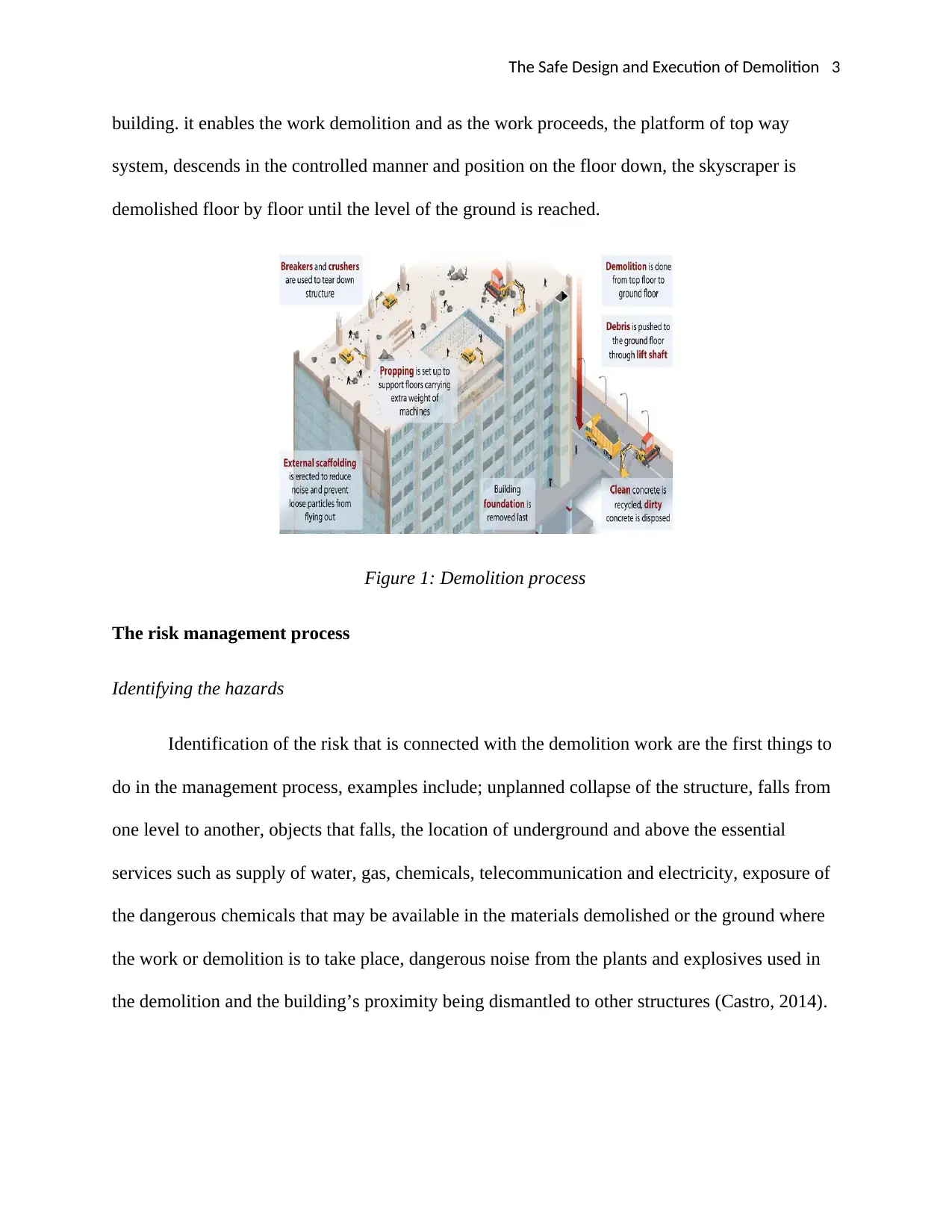
The Safe Design and Execution of Demolition 3
building. it enables the work demolition and as the work proceeds, the platform of top way
system, descends in the controlled manner and position on the floor down, the skyscraper is
demolished floor by floor until the level of the ground is reached.
Figure 1: Demolition process
The risk management process
Identifying the hazards
Identification of the risk that is connected with the demolition work are the first things to
do in the management process, examples include; unplanned collapse of the structure, falls from
one level to another, objects that falls, the location of underground and above the essential
services such as supply of water, gas, chemicals, telecommunication and electricity, exposure of
the dangerous chemicals that may be available in the materials demolished or the ground where
the work or demolition is to take place, dangerous noise from the plants and explosives used in
the demolition and the building’s proximity being dismantled to other structures (Castro, 2014).
building. it enables the work demolition and as the work proceeds, the platform of top way
system, descends in the controlled manner and position on the floor down, the skyscraper is
demolished floor by floor until the level of the ground is reached.
Figure 1: Demolition process
The risk management process
Identifying the hazards
Identification of the risk that is connected with the demolition work are the first things to
do in the management process, examples include; unplanned collapse of the structure, falls from
one level to another, objects that falls, the location of underground and above the essential
services such as supply of water, gas, chemicals, telecommunication and electricity, exposure of
the dangerous chemicals that may be available in the materials demolished or the ground where
the work or demolition is to take place, dangerous noise from the plants and explosives used in
the demolition and the building’s proximity being dismantled to other structures (Castro, 2014).
⊘ This is a preview!⊘
Do you want full access?
Subscribe today to unlock all pages.

Trusted by 1+ million students worldwide
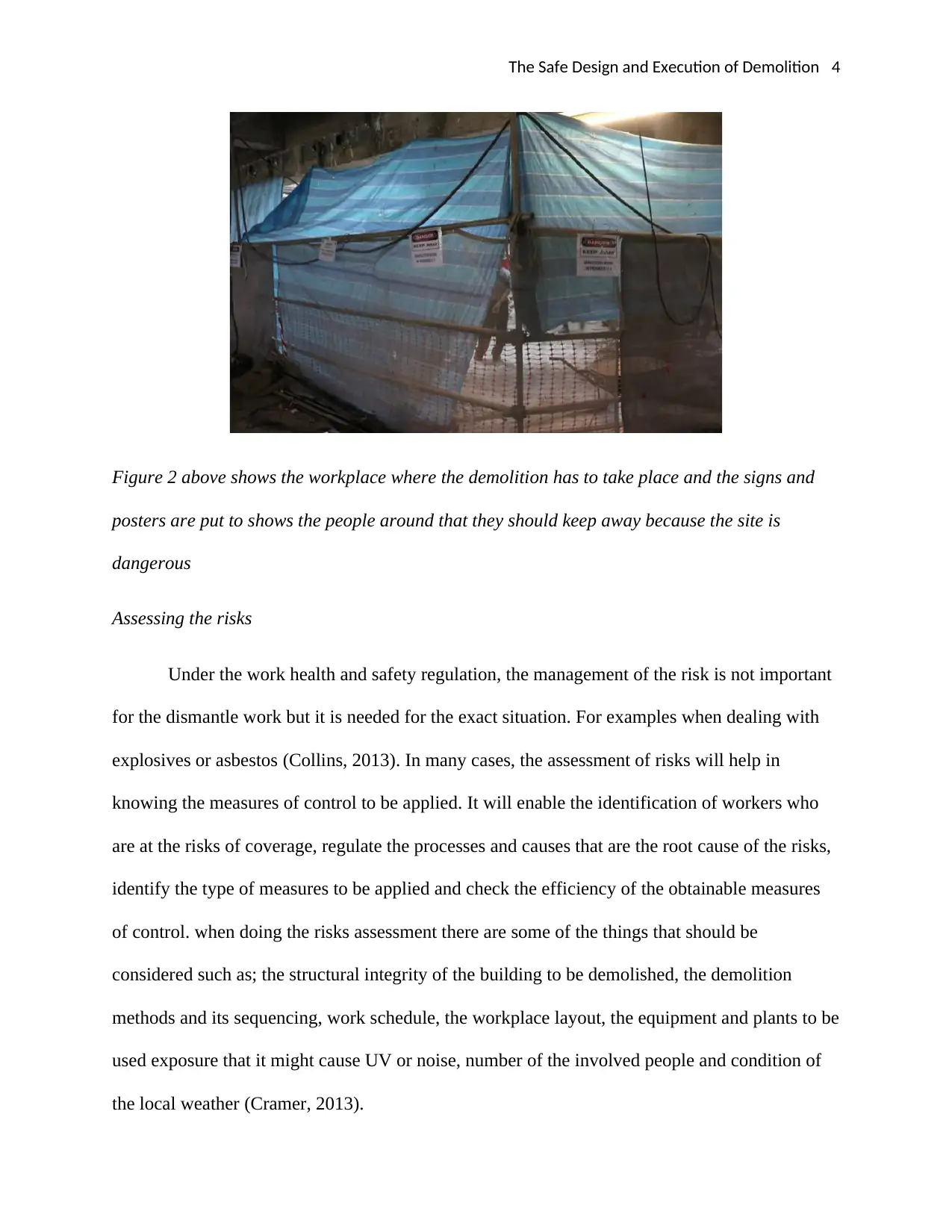
The Safe Design and Execution of Demolition 4
Figure 2 above shows the workplace where the demolition has to take place and the signs and
posters are put to shows the people around that they should keep away because the site is
dangerous
Assessing the risks
Under the work health and safety regulation, the management of the risk is not important
for the dismantle work but it is needed for the exact situation. For examples when dealing with
explosives or asbestos (Collins, 2013). In many cases, the assessment of risks will help in
knowing the measures of control to be applied. It will enable the identification of workers who
are at the risks of coverage, regulate the processes and causes that are the root cause of the risks,
identify the type of measures to be applied and check the efficiency of the obtainable measures
of control. when doing the risks assessment there are some of the things that should be
considered such as; the structural integrity of the building to be demolished, the demolition
methods and its sequencing, work schedule, the workplace layout, the equipment and plants to be
used exposure that it might cause UV or noise, number of the involved people and condition of
the local weather (Cramer, 2013).
Figure 2 above shows the workplace where the demolition has to take place and the signs and
posters are put to shows the people around that they should keep away because the site is
dangerous
Assessing the risks
Under the work health and safety regulation, the management of the risk is not important
for the dismantle work but it is needed for the exact situation. For examples when dealing with
explosives or asbestos (Collins, 2013). In many cases, the assessment of risks will help in
knowing the measures of control to be applied. It will enable the identification of workers who
are at the risks of coverage, regulate the processes and causes that are the root cause of the risks,
identify the type of measures to be applied and check the efficiency of the obtainable measures
of control. when doing the risks assessment there are some of the things that should be
considered such as; the structural integrity of the building to be demolished, the demolition
methods and its sequencing, work schedule, the workplace layout, the equipment and plants to be
used exposure that it might cause UV or noise, number of the involved people and condition of
the local weather (Cramer, 2013).
Paraphrase This Document
Need a fresh take? Get an instant paraphrase of this document with our AI Paraphraser
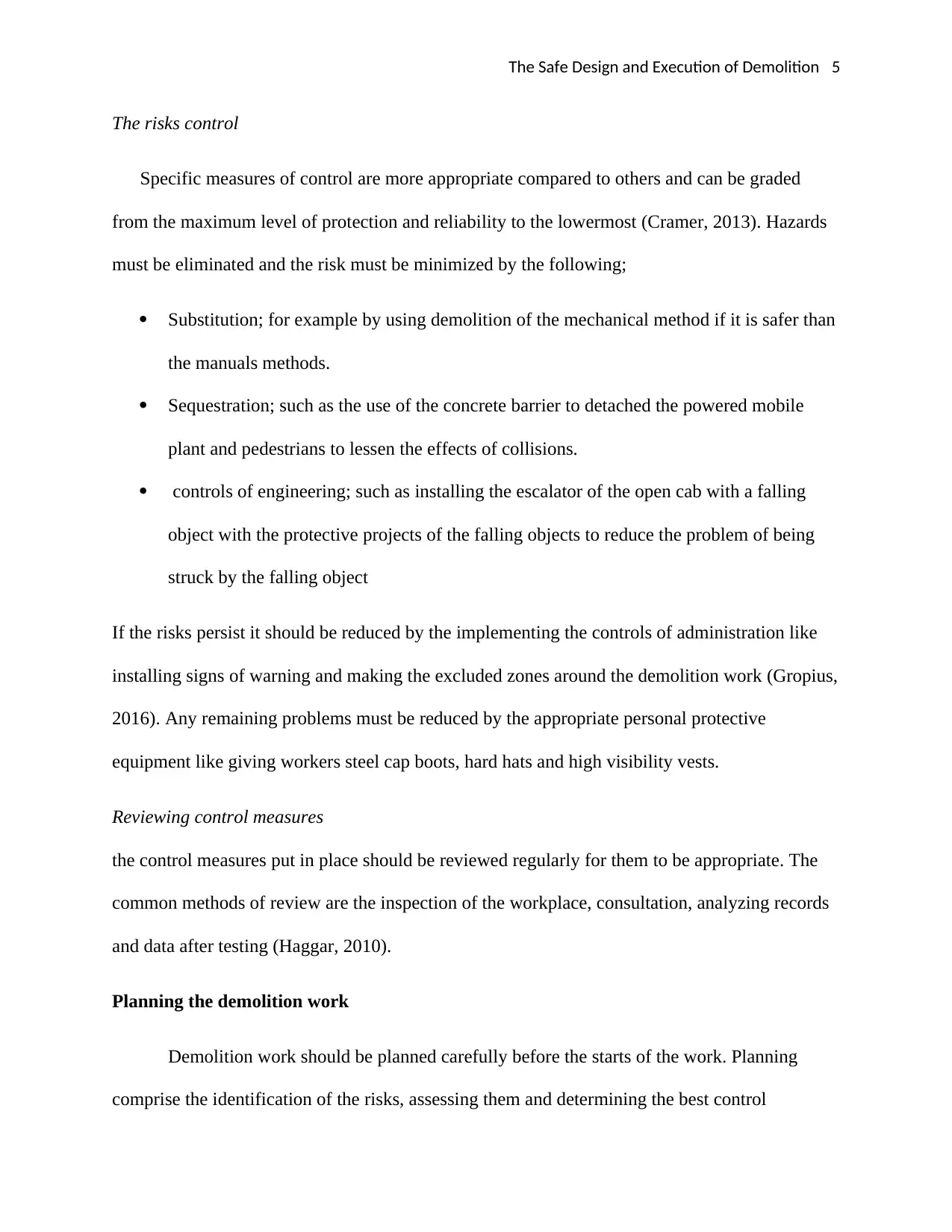
The Safe Design and Execution of Demolition 5
The risks control
Specific measures of control are more appropriate compared to others and can be graded
from the maximum level of protection and reliability to the lowermost (Cramer, 2013). Hazards
must be eliminated and the risk must be minimized by the following;
Substitution; for example by using demolition of the mechanical method if it is safer than
the manuals methods.
Sequestration; such as the use of the concrete barrier to detached the powered mobile
plant and pedestrians to lessen the effects of collisions.
controls of engineering; such as installing the escalator of the open cab with a falling
object with the protective projects of the falling objects to reduce the problem of being
struck by the falling object
If the risks persist it should be reduced by the implementing the controls of administration like
installing signs of warning and making the excluded zones around the demolition work (Gropius,
2016). Any remaining problems must be reduced by the appropriate personal protective
equipment like giving workers steel cap boots, hard hats and high visibility vests.
Reviewing control measures
the control measures put in place should be reviewed regularly for them to be appropriate. The
common methods of review are the inspection of the workplace, consultation, analyzing records
and data after testing (Haggar, 2010).
Planning the demolition work
Demolition work should be planned carefully before the starts of the work. Planning
comprise the identification of the risks, assessing them and determining the best control
The risks control
Specific measures of control are more appropriate compared to others and can be graded
from the maximum level of protection and reliability to the lowermost (Cramer, 2013). Hazards
must be eliminated and the risk must be minimized by the following;
Substitution; for example by using demolition of the mechanical method if it is safer than
the manuals methods.
Sequestration; such as the use of the concrete barrier to detached the powered mobile
plant and pedestrians to lessen the effects of collisions.
controls of engineering; such as installing the escalator of the open cab with a falling
object with the protective projects of the falling objects to reduce the problem of being
struck by the falling object
If the risks persist it should be reduced by the implementing the controls of administration like
installing signs of warning and making the excluded zones around the demolition work (Gropius,
2016). Any remaining problems must be reduced by the appropriate personal protective
equipment like giving workers steel cap boots, hard hats and high visibility vests.
Reviewing control measures
the control measures put in place should be reviewed regularly for them to be appropriate. The
common methods of review are the inspection of the workplace, consultation, analyzing records
and data after testing (Haggar, 2010).
Planning the demolition work
Demolition work should be planned carefully before the starts of the work. Planning
comprise the identification of the risks, assessing them and determining the best control
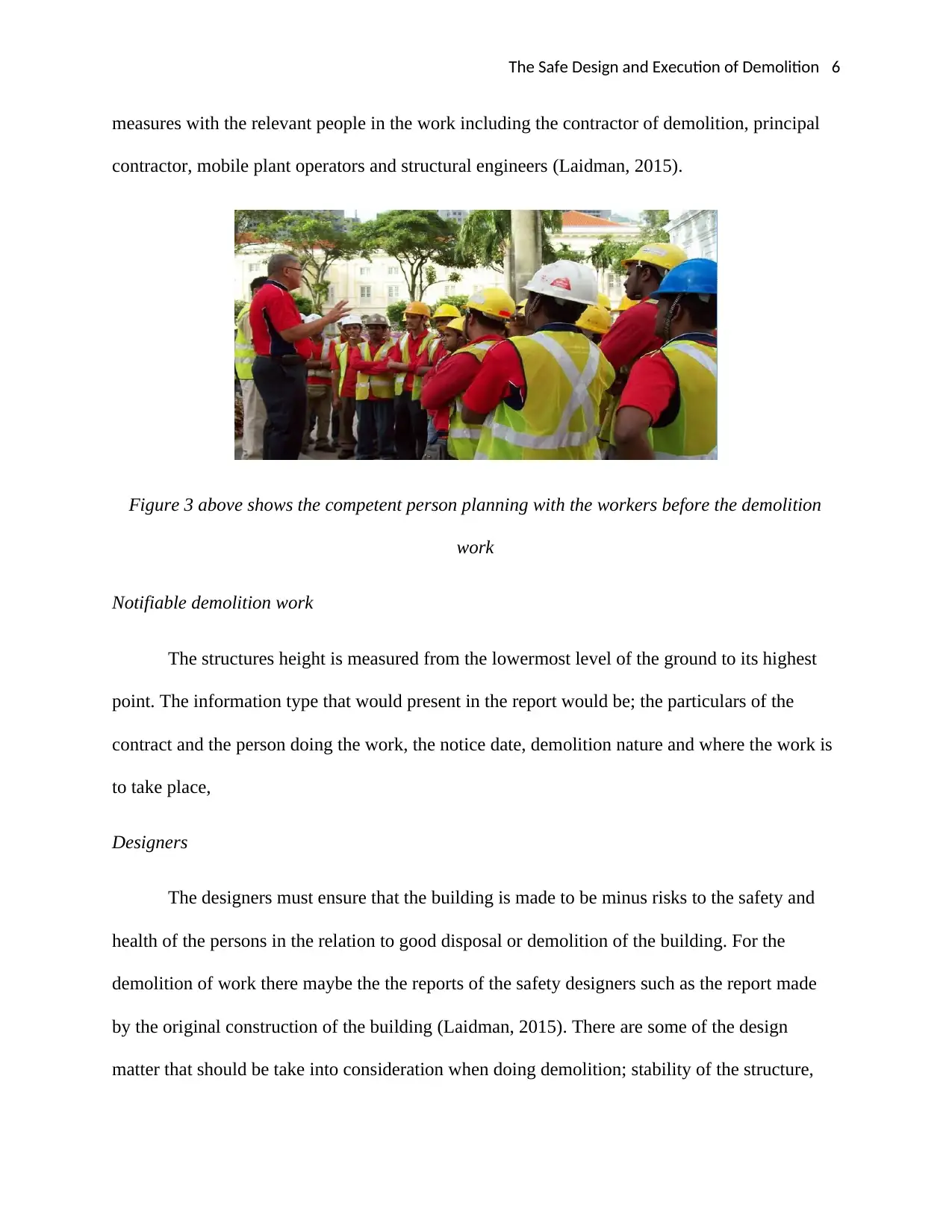
The Safe Design and Execution of Demolition 6
measures with the relevant people in the work including the contractor of demolition, principal
contractor, mobile plant operators and structural engineers (Laidman, 2015).
Figure 3 above shows the competent person planning with the workers before the demolition
work
Notifiable demolition work
The structures height is measured from the lowermost level of the ground to its highest
point. The information type that would present in the report would be; the particulars of the
contract and the person doing the work, the notice date, demolition nature and where the work is
to take place,
Designers
The designers must ensure that the building is made to be minus risks to the safety and
health of the persons in the relation to good disposal or demolition of the building. For the
demolition of work there maybe the the reports of the safety designers such as the report made
by the original construction of the building (Laidman, 2015). There are some of the design
matter that should be take into consideration when doing demolition; stability of the structure,
measures with the relevant people in the work including the contractor of demolition, principal
contractor, mobile plant operators and structural engineers (Laidman, 2015).
Figure 3 above shows the competent person planning with the workers before the demolition
work
Notifiable demolition work
The structures height is measured from the lowermost level of the ground to its highest
point. The information type that would present in the report would be; the particulars of the
contract and the person doing the work, the notice date, demolition nature and where the work is
to take place,
Designers
The designers must ensure that the building is made to be minus risks to the safety and
health of the persons in the relation to good disposal or demolition of the building. For the
demolition of work there maybe the the reports of the safety designers such as the report made
by the original construction of the building (Laidman, 2015). There are some of the design
matter that should be take into consideration when doing demolition; stability of the structure,
⊘ This is a preview!⊘
Do you want full access?
Subscribe today to unlock all pages.

Trusted by 1+ million students worldwide
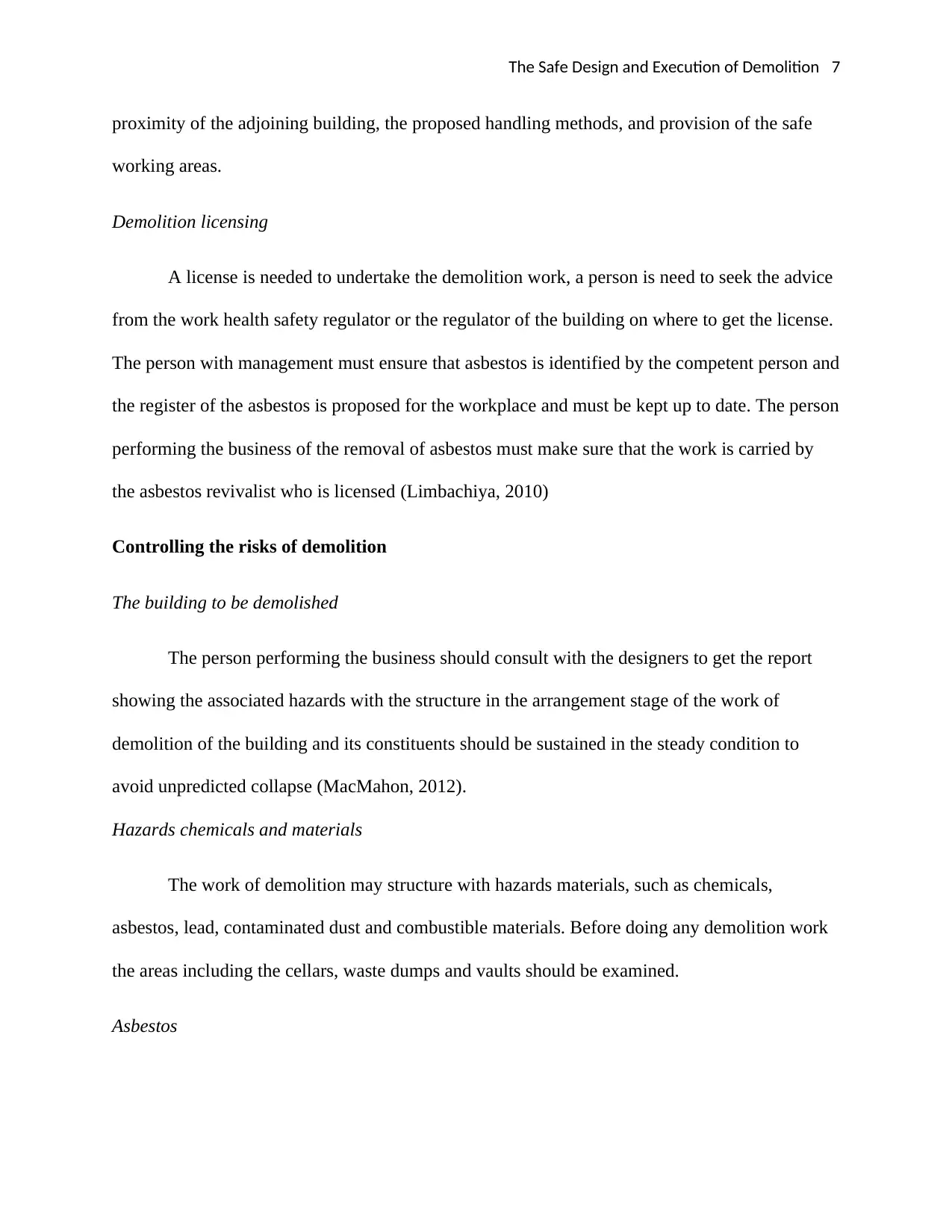
The Safe Design and Execution of Demolition 7
proximity of the adjoining building, the proposed handling methods, and provision of the safe
working areas.
Demolition licensing
A license is needed to undertake the demolition work, a person is need to seek the advice
from the work health safety regulator or the regulator of the building on where to get the license.
The person with management must ensure that asbestos is identified by the competent person and
the register of the asbestos is proposed for the workplace and must be kept up to date. The person
performing the business of the removal of asbestos must make sure that the work is carried by
the asbestos revivalist who is licensed (Limbachiya, 2010)
Controlling the risks of demolition
The building to be demolished
The person performing the business should consult with the designers to get the report
showing the associated hazards with the structure in the arrangement stage of the work of
demolition of the building and its constituents should be sustained in the steady condition to
avoid unpredicted collapse (MacMahon, 2012).
Hazards chemicals and materials
The work of demolition may structure with hazards materials, such as chemicals,
asbestos, lead, contaminated dust and combustible materials. Before doing any demolition work
the areas including the cellars, waste dumps and vaults should be examined.
Asbestos
proximity of the adjoining building, the proposed handling methods, and provision of the safe
working areas.
Demolition licensing
A license is needed to undertake the demolition work, a person is need to seek the advice
from the work health safety regulator or the regulator of the building on where to get the license.
The person with management must ensure that asbestos is identified by the competent person and
the register of the asbestos is proposed for the workplace and must be kept up to date. The person
performing the business of the removal of asbestos must make sure that the work is carried by
the asbestos revivalist who is licensed (Limbachiya, 2010)
Controlling the risks of demolition
The building to be demolished
The person performing the business should consult with the designers to get the report
showing the associated hazards with the structure in the arrangement stage of the work of
demolition of the building and its constituents should be sustained in the steady condition to
avoid unpredicted collapse (MacMahon, 2012).
Hazards chemicals and materials
The work of demolition may structure with hazards materials, such as chemicals,
asbestos, lead, contaminated dust and combustible materials. Before doing any demolition work
the areas including the cellars, waste dumps and vaults should be examined.
Asbestos
Paraphrase This Document
Need a fresh take? Get an instant paraphrase of this document with our AI Paraphraser
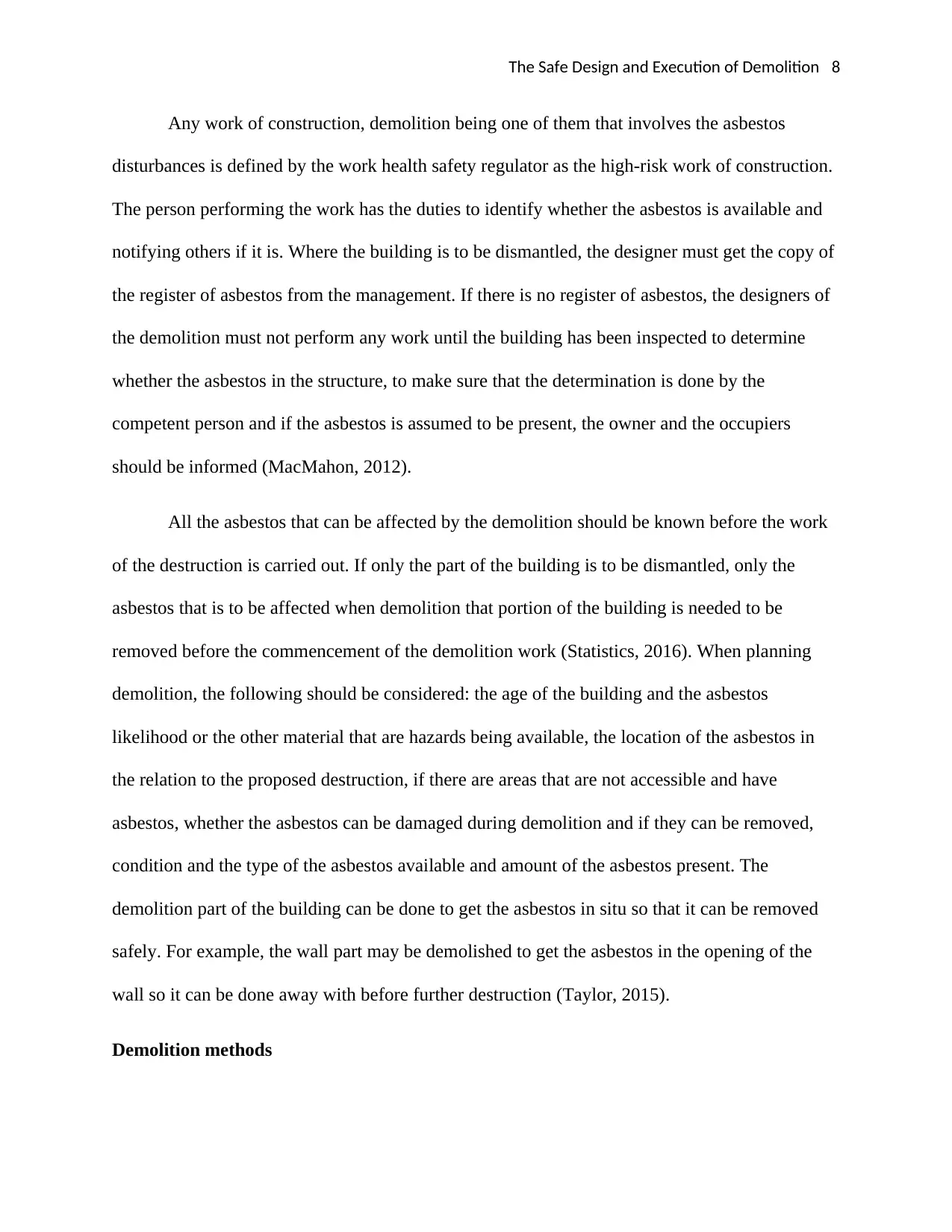
The Safe Design and Execution of Demolition 8
Any work of construction, demolition being one of them that involves the asbestos
disturbances is defined by the work health safety regulator as the high-risk work of construction.
The person performing the work has the duties to identify whether the asbestos is available and
notifying others if it is. Where the building is to be dismantled, the designer must get the copy of
the register of asbestos from the management. If there is no register of asbestos, the designers of
the demolition must not perform any work until the building has been inspected to determine
whether the asbestos in the structure, to make sure that the determination is done by the
competent person and if the asbestos is assumed to be present, the owner and the occupiers
should be informed (MacMahon, 2012).
All the asbestos that can be affected by the demolition should be known before the work
of the destruction is carried out. If only the part of the building is to be dismantled, only the
asbestos that is to be affected when demolition that portion of the building is needed to be
removed before the commencement of the demolition work (Statistics, 2016). When planning
demolition, the following should be considered: the age of the building and the asbestos
likelihood or the other material that are hazards being available, the location of the asbestos in
the relation to the proposed destruction, if there are areas that are not accessible and have
asbestos, whether the asbestos can be damaged during demolition and if they can be removed,
condition and the type of the asbestos available and amount of the asbestos present. The
demolition part of the building can be done to get the asbestos in situ so that it can be removed
safely. For example, the wall part may be demolished to get the asbestos in the opening of the
wall so it can be done away with before further destruction (Taylor, 2015).
Demolition methods
Any work of construction, demolition being one of them that involves the asbestos
disturbances is defined by the work health safety regulator as the high-risk work of construction.
The person performing the work has the duties to identify whether the asbestos is available and
notifying others if it is. Where the building is to be dismantled, the designer must get the copy of
the register of asbestos from the management. If there is no register of asbestos, the designers of
the demolition must not perform any work until the building has been inspected to determine
whether the asbestos in the structure, to make sure that the determination is done by the
competent person and if the asbestos is assumed to be present, the owner and the occupiers
should be informed (MacMahon, 2012).
All the asbestos that can be affected by the demolition should be known before the work
of the destruction is carried out. If only the part of the building is to be dismantled, only the
asbestos that is to be affected when demolition that portion of the building is needed to be
removed before the commencement of the demolition work (Statistics, 2016). When planning
demolition, the following should be considered: the age of the building and the asbestos
likelihood or the other material that are hazards being available, the location of the asbestos in
the relation to the proposed destruction, if there are areas that are not accessible and have
asbestos, whether the asbestos can be damaged during demolition and if they can be removed,
condition and the type of the asbestos available and amount of the asbestos present. The
demolition part of the building can be done to get the asbestos in situ so that it can be removed
safely. For example, the wall part may be demolished to get the asbestos in the opening of the
wall so it can be done away with before further destruction (Taylor, 2015).
Demolition methods
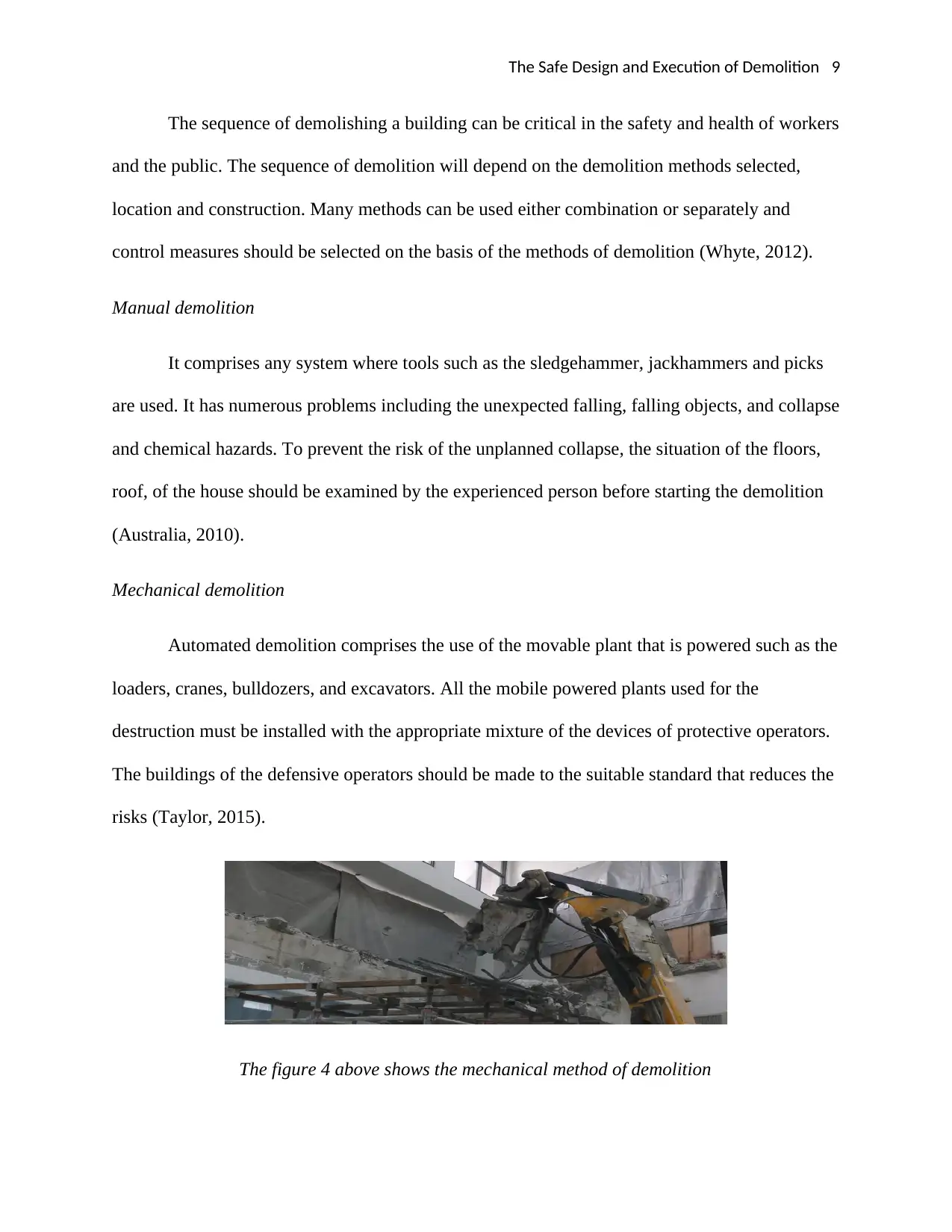
The Safe Design and Execution of Demolition 9
The sequence of demolishing a building can be critical in the safety and health of workers
and the public. The sequence of demolition will depend on the demolition methods selected,
location and construction. Many methods can be used either combination or separately and
control measures should be selected on the basis of the methods of demolition (Whyte, 2012).
Manual demolition
It comprises any system where tools such as the sledgehammer, jackhammers and picks
are used. It has numerous problems including the unexpected falling, falling objects, and collapse
and chemical hazards. To prevent the risk of the unplanned collapse, the situation of the floors,
roof, of the house should be examined by the experienced person before starting the demolition
(Australia, 2010).
Mechanical demolition
Automated demolition comprises the use of the movable plant that is powered such as the
loaders, cranes, bulldozers, and excavators. All the mobile powered plants used for the
destruction must be installed with the appropriate mixture of the devices of protective operators.
The buildings of the defensive operators should be made to the suitable standard that reduces the
risks (Taylor, 2015).
The figure 4 above shows the mechanical method of demolition
The sequence of demolishing a building can be critical in the safety and health of workers
and the public. The sequence of demolition will depend on the demolition methods selected,
location and construction. Many methods can be used either combination or separately and
control measures should be selected on the basis of the methods of demolition (Whyte, 2012).
Manual demolition
It comprises any system where tools such as the sledgehammer, jackhammers and picks
are used. It has numerous problems including the unexpected falling, falling objects, and collapse
and chemical hazards. To prevent the risk of the unplanned collapse, the situation of the floors,
roof, of the house should be examined by the experienced person before starting the demolition
(Australia, 2010).
Mechanical demolition
Automated demolition comprises the use of the movable plant that is powered such as the
loaders, cranes, bulldozers, and excavators. All the mobile powered plants used for the
destruction must be installed with the appropriate mixture of the devices of protective operators.
The buildings of the defensive operators should be made to the suitable standard that reduces the
risks (Taylor, 2015).
The figure 4 above shows the mechanical method of demolition
⊘ This is a preview!⊘
Do you want full access?
Subscribe today to unlock all pages.

Trusted by 1+ million students worldwide
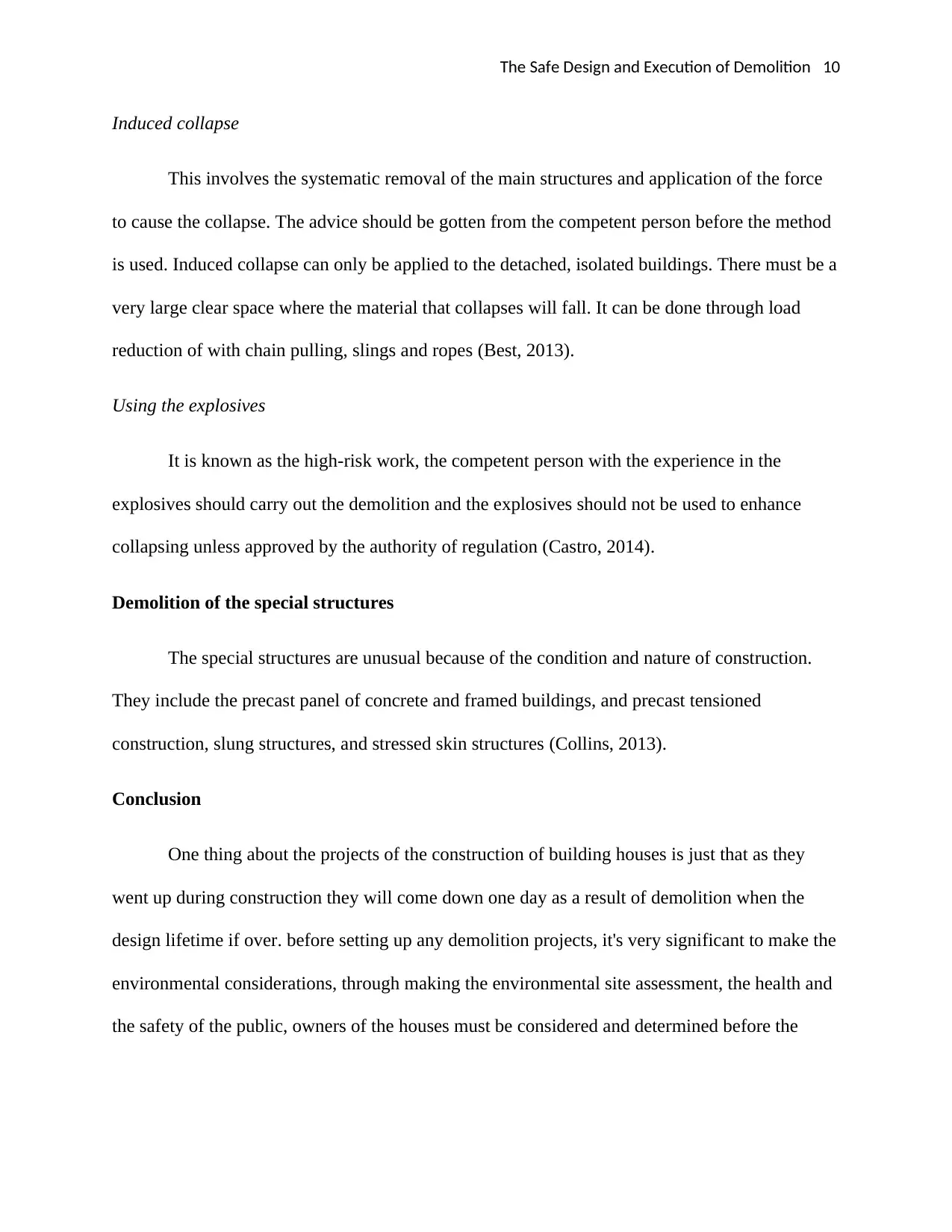
The Safe Design and Execution of Demolition 10
Induced collapse
This involves the systematic removal of the main structures and application of the force
to cause the collapse. The advice should be gotten from the competent person before the method
is used. Induced collapse can only be applied to the detached, isolated buildings. There must be a
very large clear space where the material that collapses will fall. It can be done through load
reduction of with chain pulling, slings and ropes (Best, 2013).
Using the explosives
It is known as the high-risk work, the competent person with the experience in the
explosives should carry out the demolition and the explosives should not be used to enhance
collapsing unless approved by the authority of regulation (Castro, 2014).
Demolition of the special structures
The special structures are unusual because of the condition and nature of construction.
They include the precast panel of concrete and framed buildings, and precast tensioned
construction, slung structures, and stressed skin structures (Collins, 2013).
Conclusion
One thing about the projects of the construction of building houses is just that as they
went up during construction they will come down one day as a result of demolition when the
design lifetime if over. before setting up any demolition projects, it's very significant to make the
environmental considerations, through making the environmental site assessment, the health and
the safety of the public, owners of the houses must be considered and determined before the
Induced collapse
This involves the systematic removal of the main structures and application of the force
to cause the collapse. The advice should be gotten from the competent person before the method
is used. Induced collapse can only be applied to the detached, isolated buildings. There must be a
very large clear space where the material that collapses will fall. It can be done through load
reduction of with chain pulling, slings and ropes (Best, 2013).
Using the explosives
It is known as the high-risk work, the competent person with the experience in the
explosives should carry out the demolition and the explosives should not be used to enhance
collapsing unless approved by the authority of regulation (Castro, 2014).
Demolition of the special structures
The special structures are unusual because of the condition and nature of construction.
They include the precast panel of concrete and framed buildings, and precast tensioned
construction, slung structures, and stressed skin structures (Collins, 2013).
Conclusion
One thing about the projects of the construction of building houses is just that as they
went up during construction they will come down one day as a result of demolition when the
design lifetime if over. before setting up any demolition projects, it's very significant to make the
environmental considerations, through making the environmental site assessment, the health and
the safety of the public, owners of the houses must be considered and determined before the
Paraphrase This Document
Need a fresh take? Get an instant paraphrase of this document with our AI Paraphraser

The Safe Design and Execution of Demolition 11
demolition of then work, also the houses and grounds should be assessed to ensure that chemical
hazards and asbestos are all removed before the demolition commences.
demolition of then work, also the houses and grounds should be assessed to ensure that chemical
hazards and asbestos are all removed before the demolition commences.
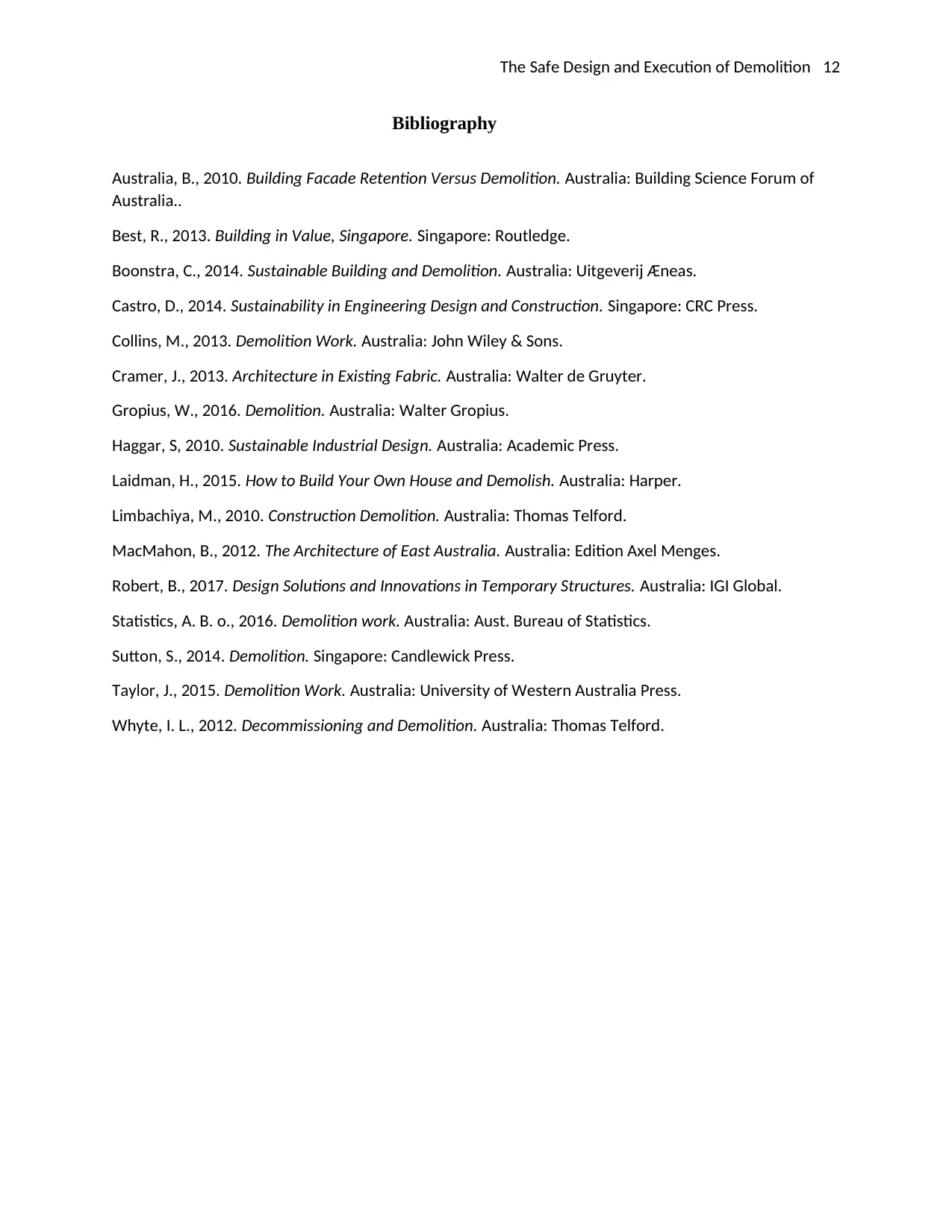
The Safe Design and Execution of Demolition 12
Bibliography
Australia, B., 2010. Building Facade Retention Versus Demolition. Australia: Building Science Forum of
Australia..
Best, R., 2013. Building in Value, Singapore. Singapore: Routledge.
Boonstra, C., 2014. Sustainable Building and Demolition. Australia: Uitgeverij Æneas.
Castro, D., 2014. Sustainability in Engineering Design and Construction. Singapore: CRC Press.
Collins, M., 2013. Demolition Work. Australia: John Wiley & Sons.
Cramer, J., 2013. Architecture in Existing Fabric. Australia: Walter de Gruyter.
Gropius, W., 2016. Demolition. Australia: Walter Gropius.
Haggar, S, 2010. Sustainable Industrial Design. Australia: Academic Press.
Laidman, H., 2015. How to Build Your Own House and Demolish. Australia: Harper.
Limbachiya, M., 2010. Construction Demolition. Australia: Thomas Telford.
MacMahon, B., 2012. The Architecture of East Australia. Australia: Edition Axel Menges.
Robert, B., 2017. Design Solutions and Innovations in Temporary Structures. Australia: IGI Global.
Statistics, A. B. o., 2016. Demolition work. Australia: Aust. Bureau of Statistics.
Sutton, S., 2014. Demolition. Singapore: Candlewick Press.
Taylor, J., 2015. Demolition Work. Australia: University of Western Australia Press.
Whyte, I. L., 2012. Decommissioning and Demolition. Australia: Thomas Telford.
Bibliography
Australia, B., 2010. Building Facade Retention Versus Demolition. Australia: Building Science Forum of
Australia..
Best, R., 2013. Building in Value, Singapore. Singapore: Routledge.
Boonstra, C., 2014. Sustainable Building and Demolition. Australia: Uitgeverij Æneas.
Castro, D., 2014. Sustainability in Engineering Design and Construction. Singapore: CRC Press.
Collins, M., 2013. Demolition Work. Australia: John Wiley & Sons.
Cramer, J., 2013. Architecture in Existing Fabric. Australia: Walter de Gruyter.
Gropius, W., 2016. Demolition. Australia: Walter Gropius.
Haggar, S, 2010. Sustainable Industrial Design. Australia: Academic Press.
Laidman, H., 2015. How to Build Your Own House and Demolish. Australia: Harper.
Limbachiya, M., 2010. Construction Demolition. Australia: Thomas Telford.
MacMahon, B., 2012. The Architecture of East Australia. Australia: Edition Axel Menges.
Robert, B., 2017. Design Solutions and Innovations in Temporary Structures. Australia: IGI Global.
Statistics, A. B. o., 2016. Demolition work. Australia: Aust. Bureau of Statistics.
Sutton, S., 2014. Demolition. Singapore: Candlewick Press.
Taylor, J., 2015. Demolition Work. Australia: University of Western Australia Press.
Whyte, I. L., 2012. Decommissioning and Demolition. Australia: Thomas Telford.
⊘ This is a preview!⊘
Do you want full access?
Subscribe today to unlock all pages.

Trusted by 1+ million students worldwide
1 out of 13
Related Documents
Your All-in-One AI-Powered Toolkit for Academic Success.
+13062052269
info@desklib.com
Available 24*7 on WhatsApp / Email
![[object Object]](/_next/static/media/star-bottom.7253800d.svg)
Unlock your academic potential
Copyright © 2020–2025 A2Z Services. All Rights Reserved. Developed and managed by ZUCOL.



